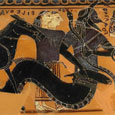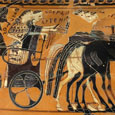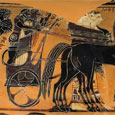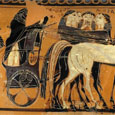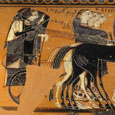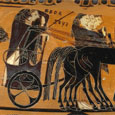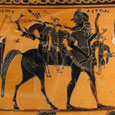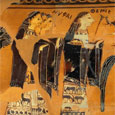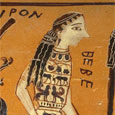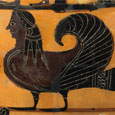Wedding of Peleus & Thetis (original) (raw)
Greek Mythology >> Galleries >> Greek Vase Paintings 6 >> P21.8
P21.8 THE WEDDING OF PELEUS & THETIS
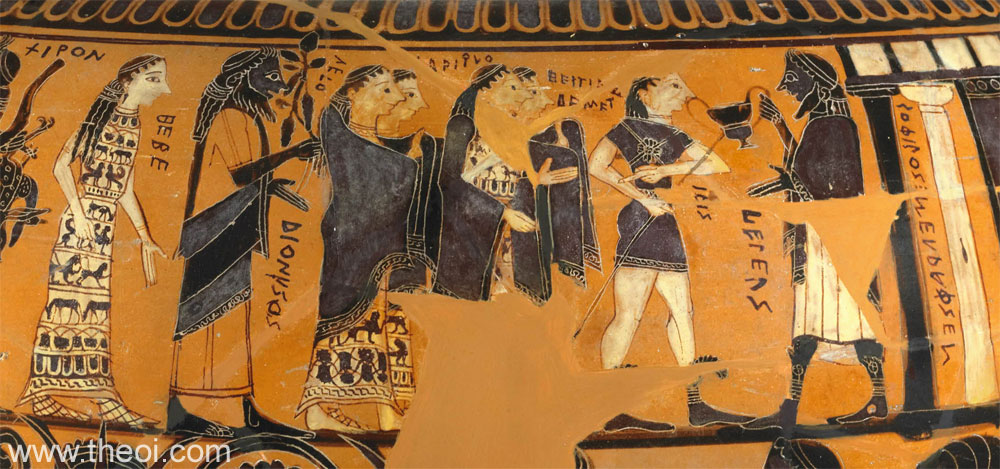
DETAILS
| Museum Collection | British Museum, London |
|---|---|
| Catalogue No. | London 1971,1101.1 |
| Beazley Archive No. | 350099 |
| Ware | Attic Black Figure |
| Shape | Dinos |
| Painter | Signed by Sophilos |
| Date | ca. 580 - 570 B.C. |
| Period | Archaic |
DESCRIPTION
Detail of Hebe, Dionysus, Leto, Chariclo, Hestia, Demeter, Iris and Peleus from a painting depicting the procession of gods attending the wedding of Peleus and Thetis.
King Peleus stands before his palace welcoming a procession of gods to his wedding feast. He holds a drinking cup in one hand and raises the other in greeting. The divine herald Iris leads the procession holding a herald's wand in one hand and pointing to the gods behind her with the other. She is dressed in a thigh-length robe embroidered with a flower at the breast and a pair winged boots. Four senior matrons follow close behind--Hestia and Demeter, Leto and Chariclo (wife of Chiron, granddaughter of Leto)--with Dionysus and Hebe. These six would preside over the wedding feast--Demeter and Hestia providing bread (as goddesses of grain and hearth), Leto and Chariclo meat (as mother and wife of the hunters Artemis and Chiron), and Dionysus and Hebe wine (as god of wine and divine cupbearer).
The complete procession features (from right to left) King Peleus, Iris, Hestia, Demeter, Chariclo, Leto, Dionysus, Hebe (this image), Chiron, Themis, three Nymphs (see image K15.1), three Horae, Hera, Zeus (see image K17.2), three Charites, Amphitrite, Poseidon (see image K21.3), five Muses, Aphrodite, Ares (see image K20.11A), four Muses, Apollo, Hermes (see image K20.11B), three Moirae, Athena, Artemis (see image K16.1), Oceanus, Tethys, Eileithyia and Hephaestus (see image O1.1).
Five pairs of gods ride chariots: Zeus and Hera, Poseidon and Amphitrite, Ares and Aphrodite, Hermes and Apollo, Athena and Artemis.
The figures, however, are mostly generic and would be indistinguishable without the name labels. The exceptions are Iris with her winged boots and wand, Dionysus with a vine, white Hebe, the centaur Chiron with a branch of hares, Themis with a sceptre, a Muse playing pipes, Apollo with a lyre, Artemis with a bow, fish-tailed Oceanus and Hephaestus riding an ass.
The painting functions as a family portrait of the main Olympian gods as described by Homer and Hesiod. The family consists of Zeus, king of the gods, his brother (Poseidon), three sisters (Hestia, Demeter and Hera), bastard brother (Chiron), four sons (Ares, Apollo, Hermes and Dionysus), stepson (Hephaestus), twenty-six daughters (Aphrodite, Athena, Artemis, Eileithyia, Hebe, three Moirae, three Horae, three Nymphs, three Charites and nine Muses), two sisters-in-law (Amphitrite and Chariclo), an uncle and aunt (Oceanus and Tethys), and three consorts and/or minions (Leto, Themis, Iris).
IMAGE DETAIL
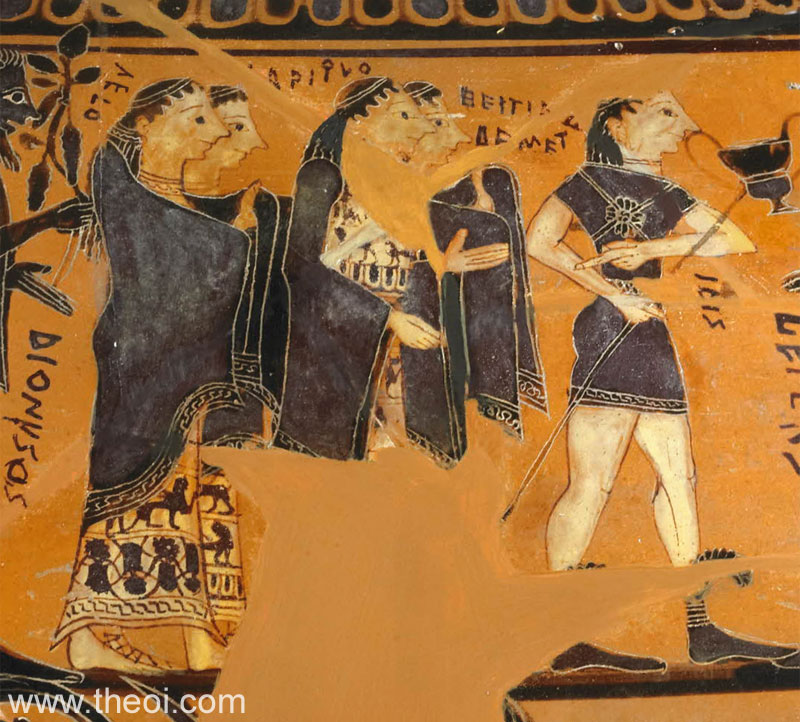
Detail of the goddesses Leto, Chariclo, Hestia, Demeter and Iris.
ARTICLES
Wedding of Thetis, Hebe, Dionysus, Leto, Chariclo, Hestia, Demeter, Iris
